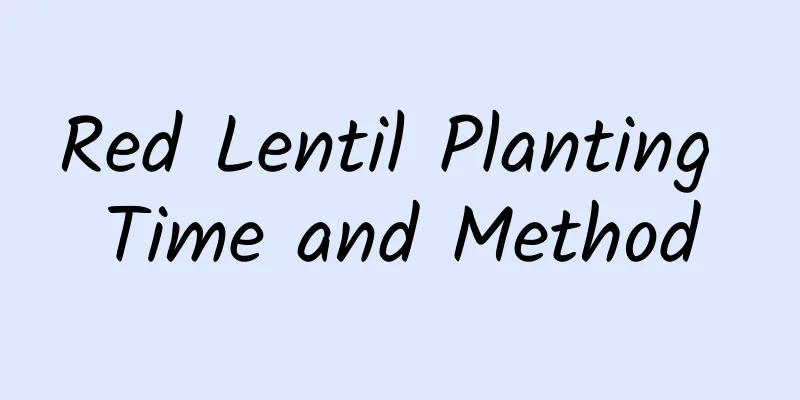The correct way to fertilize cowpea

|
Cowpea is a common vegetable in our lives. When farmers grow cowpea, the yield is relatively high. However, the yield of cowpea grown by some people is not high. This is mainly because the cowpea is not fertilized properly. Let’s talk about the correct way to fertilize cowpea. 1. The correct method of fertilizing cowpea The absorption of nitrogen, phosphorus and potassium gradually increases during the growth process of cowpea, but the absorption amount varies greatly in different growth periods. The absorption of nitrogen, phosphorus and potassium by climbing cowpea is less during the vegetative growth period, but greater during the reproductive growth period, accounting for the vast majority of the total absorption. Dwarf cowpea is different, absorbing more during the nutritional growth period. The principle of fertilizing cowpea should be based on organic fertilizer , combined with mineral fertilizer, 500-750 kg of decomposed manure and 40-50 kg of superphosphate as base fertilizer per mu. Generally, no topdressing is required during the seedling stage. It can be applied as appropriate during the vine-growing stage. 7 to 10 kg of compound fertilizer can be applied in the late vine-growing stage. If the climate is suitable and the plants grow well, 300 to 400 kg of decomposed organic fertilizer and 15 to 20 kg of compound fertilizer can be added in the late harvest stage to promote growth, increase pod setting, extend the harvest period and increase yield. 2. Six key points and techniques for high yield of beans 1. Crop rotation Beans belong to the leguminous vegetables. It is not suitable to be planted repeatedly with vegetables of the same family such as eggplant and pepper . Instead, they should be planted in rotation. Generally speaking, it is best to plant once every three years. This can effectively avoid the problem of continuous cropping in the soil and reduce the occurrence of diseases and pests, thereby ensuring the yield and quality of beans. 2. Temperature During the germination and emergence stage of bean seeds, there are higher requirements for temperature. Generally speaking, temperatures above 20 degrees are more suitable. If the temperature is too low, the seeds will fail to germinate and affect the entire growth cycle. Therefore, when planting, be sure to choose a time when the temperature is warmer. 3. Planting method There are two ways to plant beans: direct seeding and transplanting. Among them, the growth of directly planted beans will generally be more vigorous, and the yield will be higher than that of transplanted beans. Therefore, if conditions permit, try to choose direct planting, which can better ensure the yield of beans. 4. Watering and fertilizing During the growth process of beans, watering and fertilizing are very important, but it should be noted that it cannot be done blindly, otherwise it will lead to the excessive growth of the seedlings, thus affecting the later results. Generally speaking, small amounts and multiple times can be adopted to better meet the growth needs of beans. 5. Topping When the beans grow to a certain height, the vines will begin to grow rapidly. At this time, timely intervention is needed to pinch off a part of the top of the vine appropriately. This can effectively promote more flowering and pod formation of the beans, thereby increasing yield. 6. Management during pod setting period During the pod-setting period of beans, which is about 20 days after flowering, this is the critical period of bean growth, so you must do a good job of watering and fertilizing, but be careful not to overdo it, otherwise it will cause root and pod rot, affecting the yield, so you must master the principle of moderation. That’s it |
<<: Is iris cold-resistant? What are the diseases of iris?
>>: When does iris bloom and how to care for it during the flowering period
Recommend
Cactus growth environment conditions and characteristics
Cactus growth environment conditions and requirem...
How to grow red sandalwood
1. Breeding methods 1. Light: Dalbergia small-lea...
How to plant bottle orchid seeds
1. Seed selection If we want to see the life cycl...
How to propagate Euphorbia milii
Cutting propagation Cutting medium The substrate ...
The difference between decomposed and undecomposed fertilizers
Fermentation Mature fertilizers are composted and...
Which month is the best time to prune osmanthus?
Osmanthus is one of the ten traditional famous fl...
The jade tree at my neighbor's house has grown into a big old stump. When I asked why, it turned out that he watered it with this kind of water!
Huahua had said before that her neighbor was an e...
The causes and treatments of yellow leaves of Euphorbia obesa
1. Insufficient fertilizer 1. Reason: Euphorbia o...
What flowers can be placed in the office
1. Money Tree As we can tell from its name, it is...
How to grow Chinese evergreen in autumn
1. Loosen the flower soil In autumn, you can loos...
Tree growth environment conditions and characteristics
Tree growth environment conditions and requiremen...
How to grow whale flower
1. Maintenance methods 1. Temperature: Whale flow...
How to grow chamomile
How to sow chamomile Seed sowing is suitable for ...
When to fertilize lavender and how to fertilize lavender
1. Fertilization time Fertilizing lavender is mai...
Rose planting conditions: where to plant roses
Rose planting conditions Roses are generally plan...









